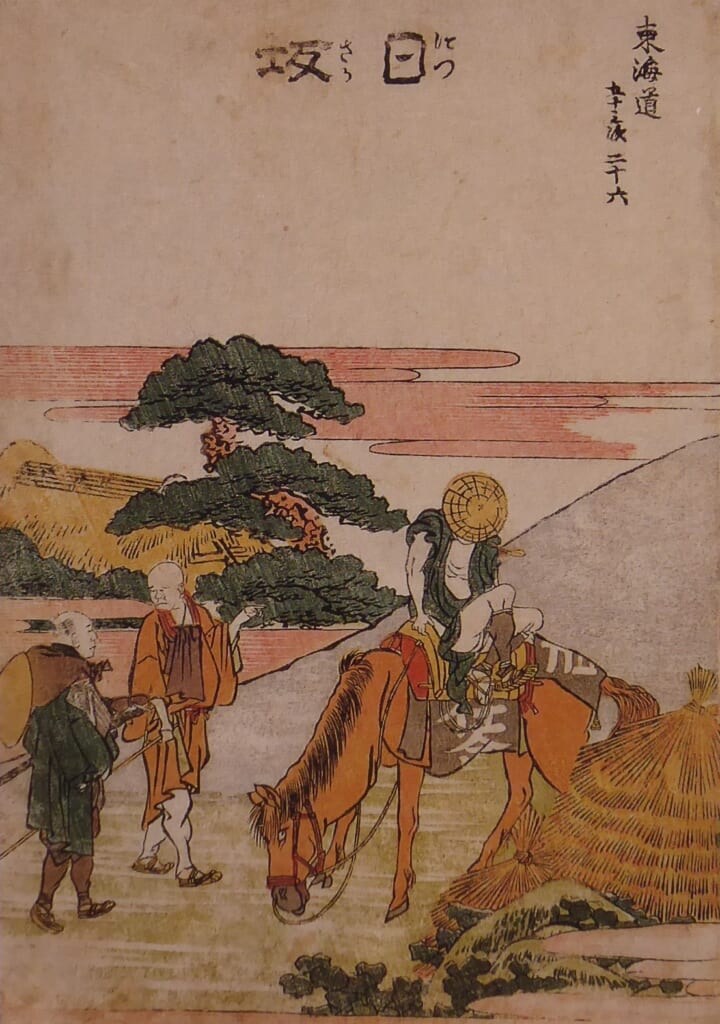Explanation of the Fifty-three Stations of the Tokaido 26 Nitsusaka
7.1km from Kakegawa to Nitsusaka, 34°48′15″N 138°04′30″E
Nitsusaka is the 25th post station of the Fifty-three Stations of the Tokaido.
Currently Nitsusaka, Kakegawa City, Shizuoka Prefecture.
It is located at the western foot of Sayanonakayama, one of the three most difficult passes on the Tokaido.
The distance from Kanaya to Nitsusaka is short, about 6.5km, but the road is difficult, starting from Kanayazaka and crossing the Sayanakayama pass.
Hizaka was a post station that already existed in the Middle Ages, and is written as “Irisaka”, “Shinzaka”, and “Nishizaka”.
The Tokaido Bunkan-no-zu (map of the Tokaido) shows it as “Shinzaka”.
Nitsusaka was designated as a post station on the Tokaido in 1601.
According to records from 1843, there was one main inn, one side inn, and 33 inns, making it a small post town on the Tokaido.
The inn was six and a half blocks long from east to west, with a population of 750 and 168 houses.
The role of a post town as determined by the shogunate was a considerable burden for a small village.
Sayo no Nakayama Pass is located between Nitsusaka Post Town and Kanaya Post Town.
It was a difficult section of the road with steep slopes. It is buried under dense trees.
At the time, bandits were rampant, so it was not easy even for adults to cross the pass.
Today, roads and parks have been developed, and the area is popular as a hiking and historical site walking course.
Sayo no Nakayama is home to the legend of the “Crying Stone.”
The legend of the crying stone began when a pregnant woman who had come to Kuenji Temple to pray for a safe delivery was attacked and killed by bandits on her way over Nakayama Pass.
In order to save the baby that was born from the incision in her stomach, the mother’s soul moved onto a nearby stone and cried.
A monk from the temple who heard the baby’s cries picked him up.
The baby was given starch syrup instead of milk and was raised with great care.
It is said that the child grew into a fine young man and avenged his mother’s death.
The Crying Stone is currently placed next to the Sayo no Nakayama Tunnel.
A similarly shaped stone is enshrined at Kuenji Temple, which is also associated with the legend.
The specialty of Nitsusaka-juku is warabimochi.
The warabimochi at this inn was made using kuzu powder instead of bracken powder.
In 1845, a traveler on a pilgrimage to Ise via the Tokaido wrote in his memorandum, “Nitsusaka warabimochi 16 mon.”
Hizakurige’s Yaji and Kita arrived at Nitsusaka-juku around 8 (around 2 p.m.) but it was pouring rain.
At the recommendation of the innkeeper, I decided to stay at Nitsusaka-juku.
In the Meiji era, the Tokaido Main Line was built around Sayo-no-Nakayama and did not pass through this post town, so the post town fell into decline.
After the war, National Route 1 was built to bypass the southeast of the post town by opening a new route through the valley on the north side of Sayo-no-Nakayama.
① “Hoeido version”
At Sayo-no-Nakayama. There is a legend of the Night Crying Stone.
The steep slope is one of the most difficult parts of the Tokaido.
The large stone at the bottom of the slope is the legendary Night Crying Stone.
The baby was raised with care, fed starch syrup instead of milk.
The child was raised with candy, and the stone has become a famous product known as “child-raising candy.”
Child-raising candy is a starch syrup made from glutinous rice and barley.
② “Gyousyo version”
The large stone in the center is the Night Crying Stone.
The traveler stops to look at the stone.
③ “Reisho version”
The large stone in the center is the Crying Stone.
In this composition, the slope is not steep, even though it is said to be crossing the pass of Sayo-nakayama.
In the Hoeido version, it is depicted as being extremely steep.
④ “Hokusai version”
This is a view of crossing the pass of Sayo-nakayama, but there is no customary Crying Stone.
⑤ “Travel image”
This is the notice board in Nitsusaka.
⑥ “Stamp image”
This is a stamp from the Nitsusaka Regional Promotion Association.
Hoeido version

Gyousyo version

Reisho version

Hokusai version

Travel image

Stamp image



